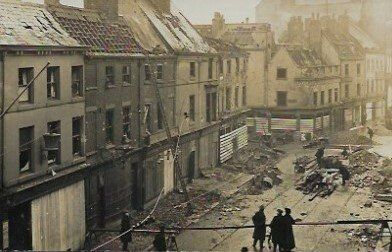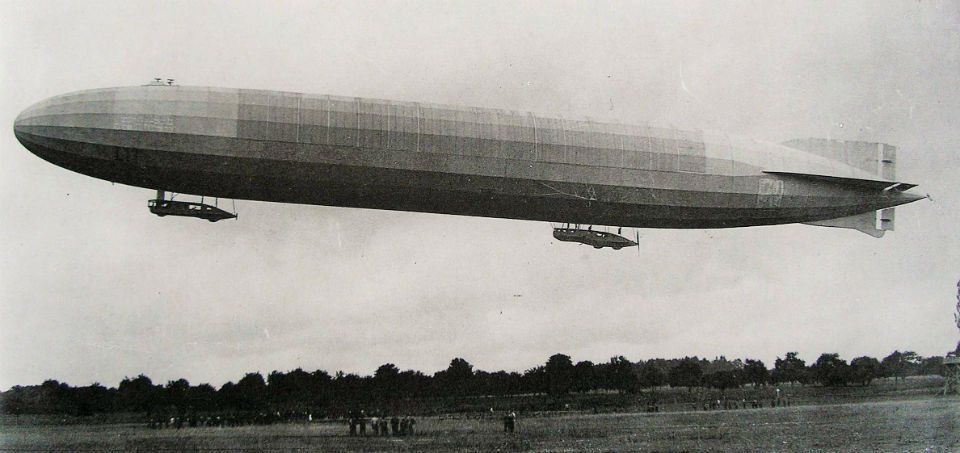ZEPPELINS, GOTHAS & 'GIANTS'
THE STORY OF BRITAIN'S FORGOTTEN BLITZ 1914-1918
5/6 March 1916
Bombed:
E. Yorks., Lincs., Leics., Rutland & Kent
On 5th March the German Naval Airship Division planned a three Zeppelin raid with the main target the shipyards on the Firth of Forth and a secondary target of establishments on the rivers Tyne and Tees. All three Zeppelins, L 11, L 13 and L 14 encountered snowstorms and were blown off course by fierce winds.
Zeppelin L 14, commanded by Böcker appeared over the coast at Flamborough Head at about 10.30pm and after eventually establishing her position, tried to fly north up the coast but struggled to make progress against a 54mph headwind. At 11.25pm she flew west from Barmston and dropped an incendiary bomb in a field near the hamlet of Gembling. From there she seems to have finally abandoned her attempts to fly north and turned south and at about midnight dropped three high-explosive (HE) and three incendiary bombs in fields at Woodmansey, about a mile from Beverley. From there the city of Hull was clearly visible, its snow-covered streets standing out clearly against the blackness of the Humber. L 14 dropped the first of seven HE bombs over the city at about 12.05am, making an unhurried attack as Hull had no anti-aircraft guns. Freezing water-contaminated fuel affected his speed when it caused two engines to fail for a time. The first bomb landed in the grounds of Hymer College, followed by one on a railway embankment just south of the college and east of the Anlaby Road junction, which smashed many windows. Then one damaged a grocer’s shop in Bean Street, while others destroyed homes in Regent Street (killing James Collinson and James Pattison), Linnaeus Street (killing three sisters, Martha, Ethel and Mira Ingamells) and Day Street. The last HE bomb dropped on Albert Quay wrecking a crane. L 14 also dropped nine incendiary bombs on the town and four that fell in the river.
L 14 headed south from Hull towards Killingholme where a 6-pdr and a 1-pdr AA gun opened fire at about 12.30am causing L 14 to turn away to the east before dropping a single HE bomb over Burstwick, which fell harmlessly. Then, steering to the north-east, she dropped four HE and two incendiary bombs over Owstwick at about 12.40am, again without any damage, before passing out to sea about five minutes later.
Zeppelin L 11, commanded by Viktor Schütze, came inland before L 14, at about 9.45pm, crossing the coast inland near Tunstall, east of Hull. Having circled for a while she headed south, passing Grimsby at 10.10pm then turned inland, her engines heard from Market Rasen at 10.30pm and ten minutes later reports placed her two miles south of Lincoln. At this point Schütze seems to have realised how far off course he was and turned back battling into the wind. He eventually fought his way back to the Humber in atrocious weather to arrive at Hull at about 1.00am, a little less than an hour since L 14 had departed. Crossing the Humber at a height estimated as low 3,000 to 4,000ft, L 14 dropped an HE bomb that landed in the river close to Earle’s Shipyard. The following day the effects of the blast saw the partial collapse of a 3,000-ton steamer on the stocks. L 11 followed the bank of the Humber before turning over the city at the mouth of the Hull, dropping a concentration of bombs around Queen Street, which destroyed a number of buildings, killed a café manager, Edward Slip, and damaged several others including a Royal Artillery office. Holy Trinity Church, which narrowly avoided destruction in the June 1915 raid escaped again with just broken stained glass windows this time. A group of incendiaries landed close to Princes Dock, one of which caused a fire on the quayside. A fire at the Mariners’ Almshouses in Carr Lane killed Edward Leadner, aged 89, and other bombs damaged the roof of the Paragon Railway Station where L 11 appeared to hover for a few minutes. She then dropped a devastating bomb on Collier Street. The blast demolished or seriously damaged 20 houses nearby. At 32 Collier Street the bomb killed 36-year-old Charlotte Naylor as well four of her children; her husband survived but lost an eye.
L 11 now turned away, flew back across the city and across the Humber towards Killingholme where the AA guns opened fire again. In response L 11 dropped four HE bombs. One damaged railway track at South Killingholme, mortally wounding a railway worker, while the others exploded without causing further damage or injury.
The third Zeppelin to raid Britain that night was Heinrich Mathy’s L 13. Mathy was in fact the first to come inland, at about 9.15pm. But having been dogged by engine problems, a snowstorm over the North Sea and extremely poor visibility, Mathy was way off course. He believed he was near Sunderland but was actually many miles to the south, at North Cotes in Lincolnshire near the mouth of the Humber. Mathy struggled to confirm his position and at one point reports placed him a few miles east of Nottingham while he still had hopes of reaching Scotland! After further engine problems Mathy gave up on his target and hoped instead that the wind would carry him south to Hull - unknowingly he was already well south of the Humber and began a flight from the east Midlands that eventually took him to the Kent coast. To lighten his ship Mathy released 32 incendiary bombs at about 11.15pm, which fell in open fields between the church and the village of Sproxton in Leicestershire. Then, a few minutes later, Mathy he dropped a single HE bomb on the village of Edmondthorpe without damage, followed by 14 or 15 HE bombs which also landed harmlessly, on grass or arable fields in the triangle formed by the villages of Thistleton, Market Overton and Greetham.
His ship now lightened, Mathy and L 13 continued on this course to the south-east but only at about 1.15am on approaching a large estuary, which he at first thought was the Humber but then recognised as the Thames, did he realise just how far off course he was. Mathy attempted to battle against the wind near Shoeburyness to make an attack, receiving two rounds from the AA gun there before its traversing gear jammed. L 13 then tried to battle against the 44mph northerly wind over the Isle of Sheppey. Mathy managed to hold his position at about 9,000ft over Sheerness for about 10 minutes, during which time he dropped four HE bombs, which landed near Minster-in-Sheppey, on Ripley Hill Marshes and Danley Farm. Neither the bombs nor the 6-pdr gun at Sheerness that fired in response had any effect. Further guns opened on L 13 as she resumed her south-east journey across Kent and passed out to sea near Deal at about 2.25am. By the time L 13 reached safety she had only two of her four engines running.
Casualties: 18 killed, 52 injured
Damage: £25,005
Follow Us
© Ian Castle 2021

